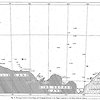The final AAE cruise
In many respects, Aurora’s last voyage with the AAE was the most successful of a successful series of scientific cruises. Its principal purpose was to collect the remaining men at Cape Denison, but Davis continued his methodical mapping of the sea floor throughout the cruise from Hobart to Adelaide via Macquarie Island and Antarctica.
If there was any expectation among Aurora’s company that Mawson’s difficult times had tired him of Antarctica, the leader soon put that to rest as soon as he came aboard the ship. Before the ship left Cape Denison, Mawson took himself off in the ship’s launch to explore the Mackellar Islets, rocky outcrops a few kilometres offshore.
Mawson also had John Hunter dredging for biological specimens, with considerable success, in the shallow waters of Commonwealth Bay. In one haul on 6 January, Mawson recorded in his diary ‘well over ½ ton of stuff’ and compared the catch favourably with results from WS Bruce’s highly-successful 1902–04 expedition.
Departing Cape Denison, Aurora had to endure a storm that took away the launch from its decks, denying Mawson the opportunity to do some inshore exploring later in the cruise. Then Davis once again turned the ship westward along the Antarctic coast. This time, without the pressures of landing or retrieving the Western Base, the voyage could focus fully on science.
Early in January Davis was able to extend his charts by mapping a coastline to the west of Adélie Land that ice had prevented him from seeing in earlier voyages. When ice again forced the ship seaward, a heavy and demanding program of dredging and netting began.
This program, comprising 11 deep-sea dredging stations and regular tow-nettings in waters up to several kilometres deep, was the most intensive Antarctic marine exploration since (and perhaps including) the Challenger expedition 40 years earlier.
John Hunter was the main biological collector, helped by the Macquarie Island veteran Harold Hamilton. His collection from the voyage included six specimens of the rare Ross seal and a large collection of external and internal parasites from birds, seals and fish. The specimens and seafloor detritus brought aboard opened up a whole new world of glacial ebbs and flows and evolving life forms and ecosystems down the ages.
Aurora finally turned northward in early February after detailed mapping of Drygalski Island (the western extremity of the cruise) and Shackleton Ice Shelf.


